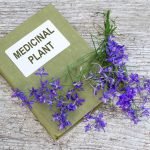Psychedelic Science: Spirituality as Medicine
Erica Zelfand, ND
Tolle Totum
Are psychedelic users happier than the rest of us?
According to a recent study in the Journal of Psychopharmacology, the answer is yes. Whereas lifetime use of non-psychedelic illicit drugs (such as meth, heroin, and cocaine) are largely associated with an increased likelihood of psychological distress and suicide, the data on psychedelics is compellingly the opposite. Pooling five years’ worth of statistics from the National Survey on Drug Use and Health, researchers at the University of Alabama found those who used psychedelics even once in their lives were 19% less likely to report psychological distress than non-psychedelic users. Controlling for a range of covariates, they discovered that of the 190 000 total people surveyed, the 27 235 who reported a history of psychedelic use were 36% less likely to have attempted suicide within the last year.1
But if psychedelics can make people happier, what else can they do? Do they have a place in medicine? In naturopathic medicine? And how do they even work?
We’re in the process of finding out. After a long prohibition on psychedelic research, the FDA has approved several clinical trials on psilocybin (the active ingredient in “magic mushrooms”), LSD (“acid”), and MDMA (“ecstasy”) in the treatment of anxiety, depression, addiction, post-traumatic stress disorder (PTSD), and other conditions. 2 This recent boom in psychedelic research is largely thanks to the Multidisciplinary Association of Psychedelic Studies (MAPS), a nonprofit organization that’s funding many of the clinical trials.2
Put aside the stereotypes of long hair and tie-dye: the developments in psychedelic medicine are imbued with scientific rigor. Recent studies demonstrate not only the efficacy of these medicines in treating a host of psychological ailments, but also offer us insight into how they work.
LSD and Psilocybin for Anxiety, Depression, and Addiction
Breaking harmful neural patterns and allowing the brain to make new connections is one of the mechanisms by which psychedelics improve mental health. In 2016, neuropsychopharmacologist Robin Carhart-Harris scanned the brains of 20 healthy volunteers over the course of a 6-hour LSD session in a study conducted as part of the Beckley/Imperial Research Programme. These scans, when compared to those of control volunteers, revealed reduced activity in the default-mode network, an area of the brain responsible for mindless, automatic, background thinking. In depression, for example, the network’s pattern is one of self-deprecating thoughts such as “nobody likes me” or “I’m a loser.” Many psychologists, in fact, believe that depression, anxiety, and obsessive-compulsive disorder may be the result of a “hyperactive” default-mode network. Conversely, Carhart-Harris’s work has shown that, under the effects of LSD and psilocybin, the default-mode network becomes less active; concurrently, separation between the brain’s resting state networks diminishes overall and greater functional connectivity has been observed. 3,4
In an interview with Imperial College London, Carhart-Harris explained that these changes are also related to “ego-dissolution,” in which the user’s “normal sense of self is broken down and replaced by a sense of reconnection with themselves, others, and the natural world.”5 This is often felt as a religious or spiritual experience, one that is associated with sustained improvements in well-being long after the direct experience has ended.6 The importance of this spiritual experience is noted in several other studies.
Charles Grob, a professor of psychiatry at the University of California, Los Angeles (UCLA), was the first to win FDA approval since the 1960’s for a phase 1 pilot study demonstrating the safety and efficacy of psilocybin in the treatment of anxiety in cancer patients.7 His trial was followed by larger randomized, double blind, crossover, phase 2 trials at Johns Hopkins University and New York University, the results of which were published in December 2016. Together, the 2 trials included 80 patients with a life-threatening cancer and a diagnosis of depression and/or anxiety who were administered either a single high dose of psilocybin or a placebo (a very low dose of psilocybin in one and niacin in the other study) in conjunction with psychotherapy. The results of these trials revealed surprisingly similar outcomes: about 80% of the cancer patients treated with psilocybin showed clinically significant reductions in depression and anxiety symptoms and increased quality of life, and the improvements were sustained at a 6-month follow-up. No flashbacks, psychosis, or other serious adverse symptoms were reported. In both trials the intensity of the mystical experience described by patients correlated with the degree to which their depression and anxiety abated.8,9 In other words, the more spiritual the experience, the more healing the therapy.
The importance of spiritual experience has been noted in other research. In a recent study, 15 smokers received 2 to 3 doses of psilocybin in the context of cognitive behavioral therapy (CBT) sessions for smoking cessation. Of the 15 participants, 12 (80%) demonstrated biologically verified smoking abstinence at a 6-month follow-up10 and 67% were smoke-free at a 12-month follow-up.11 There were no significant differences in the general intensity of the drug’s effects among participants, yet those who reported having mystical experiences during psilocybin use had greater success in giving up tobacco.10 The authors concluded: “Mystical-type subjective effects, rather than overall intensity of drug effects, were responsible for smoking cessation.”10 The long-term efficacy of psychedelics, in other words, may come from their ability to engender a transformative, mystical experience.
This phenomenon may likewise explain the efficacy of LSD in abating alcohol addiction. Between 1954 and 1960, psychiatrist Humphry Osmond and biochemist Abram Hoffer treated over 2 000 alcoholics with LSD, reporting a 1-year recovery rate of 40–45%. Osmond coined the term psychedelic in 1957, from the Greek words psyche, for mind or soul, and deloun, for show, reflecting his belief that spiritual experience is the cornerstone of psychedelic medicine.12,13
A meta-analysis of randomized controlled trials evaluating the clinical efficacy of LSD in the treatment of alcoholism pooled findings from 6 eligible trials, including 536 participants. The authors concluded: “A single dose of LSD, in the context of various alcoholism treatment programs, is associated with a decrease in alcohol misuse.”14
When administered responsibly, classic psychedelics like psilocybin and LSD appear to enhance a patient’s awareness, willingness, and ability to heal. Research indicates that they do this by decreasing activity in the default-mode network of the brain, enhancing neural connectivity, temporarily quieting the ego, and inducing a spiritual experience. These shifts may empower the patient to address the wounds and harmful neural habits at the core of their anxiety, depression, addiction, and other ailments.
MDMA for Post-Traumatic Stress Disorder
3,4-Methylenedioxy-methamphetamine (MDMA), the active ingredient in the street drug known as ecstasy, is a synthetic compound made from an extraction of sassafras oil. Unlike psilocybin and LSD, MDMA does not cause hallucinations and seems to elicit healing through somewhat different mechanisms than the psychedelics explored above.15 MDMA has been used as an underground adjuvant to psychotherapy under the nickname “Adam” since the 1970s.16 It was only recently, however, that the FDA approved clinical trials to assess the medicine’s safety and efficacy in the treatment of PTSD.17
In a randomized, controlled clinical trial, 20 survivors of sexual abuse who had been unresponsive to psychotherapy and pharmacotherapy were randomly assigned to undergo 2 MDMA-assisted or non-MDMA assisted (placebo) psychotherapy sessions of 6–8 hours’ duration. In addition, all participants received preparatory and follow-up non-MDMA psychotherapy sessions. Two months later, 83% of those in the MDMA-treated group no longer qualified for a diagnosis of PTSD, compared with 25% of those in the unassisted psychotherapy group.18
In a follow-up to his study, psychiatrist Michael Mithoefer found that the Clinician-Administered PTSD Scale (CAPS) and Impact of Events Scale-Revised (IES-R) scores of these patients dropped even farther at a 3.8-year follow-up than they had at the 2-month follow-up. The participants did better the farther out they were from MDMA-assisted psychotherapy, suggesting that the treatment provided not only immediate relief, but also a path of continued and sustained healing.19 Mithoefer has recently completed another clinical trial on MDMA in combat veterans, soon to be published.
Following naturopathic principles, the optimal treatment of PTSD would include not only palliative strategies to calm the symptoms of the condition, but also a carefully executed re-examination and re-processing of the triggering trauma. MDMA-assisted psychotherapy does both. When used in conjunction with psychotherapy, MDMA helps patients identify the root cause of their suffering without becoming re-traumatized. By acting as a serotonin agonist, MDMA reduces both depression and fear, allowing the patient to focus on their trauma during therapy sessions without triggering the sympathetic nervous system and becoming overwhelmed by negative thoughts or feelings. Through its action at 5-HT-2A receptors, MDMA further allows patients to think about things from different angles and make new connections and associations. MDMA allows a patient to feel calm through its action at alpha-2 receptors, yet it’s also a dopamine and norepinephrine agonist and thereby increases alertness. This balance of relaxation and attentiveness contributes to what in therapy is referred to as the “optimal arousal zone,” in which the patient feels engaged and ready to heal without becoming over stimulated. MDMA further supports psychological healing by enhancing oxytocin production, thereby increasing self-love, improving trust with the therapist, and ultimately enhancing the therapeutic alliance.20 In a 2014 study lead by Professor David Nutt, MRI scans of volunteers who had taken MDMA showed reduced blood flow in the visual cortex and limbic system, but increased communication between the amygdala and the hippocampus. This further explains the medicine’s efficacy in the treatment of PTSD.21
Psychopharmacologist and psychiatrist Julia Holland explained: “It’s almost like anesthesia for surgery… It allows you to dig and get to the malignant thing that needs to be pulled out and examined. It takes years in psychotherapy to dig around the trauma and start to get to it. This is a way for people to process the core issue in order to move forward… You basically couldn’t design a molecule that is better for therapy than MDMA.”22
Can a pill really solve a person’s deepest problems? When I asked Dr Mithoefer this question, he had this to offer: “It’s not that people get blissed out and then they’re fine. This is hard work, and it’s painful. The MDMA makes it possible, but it’s still not easy… MDMA catalyzes a process that keeps unfolding for days, weeks, months, and even the rest of your life.” In other words, MDMA isn’t a magic cure in and of itself, but rather a powerful catalyst for psychotherapy. Whereas SSRIs, benzodiazepines, and other medications numb the unpleasant symptoms of PTSD, MDMA allows patients to dig deep within themselves to heal it.
In December 2016, the FDA approved phase 3 trials of MDMA-assisted psychotherapy. MDMA could be moved from the DEA’s Schedule I to Schedule II as early as 2021.23 This would make it a therapy that those of us with DEA licenses could feasibly prescribe and administer.
Conventional and Naturopathic Alternatives to Psychedelic Medicine
The pharmaceutical therapies currently used in the treatment of depression, anxiety, addiction, and PTSD typically include serotonin reuptake inhibitors (SSRIs), benzodiazepines, and substances that mimic drugs of abuse (such as nicotine replacement for smokers). Serotonin reuptake inhibitors often take 4–6 weeks to deliver noticeable benefit, can be difficult to discontinue, require daily dosing, and can increase suicidality in some.24 The link between low serotonin and depression has come under recent scrutiny, challenging the rationale for the use of SSRIs.25,26 Benzodiazepines offer faster-acting relief of symptoms, but can quickly become addictive.27 Nicotine gums and patches ease withdrawal symptoms by stimulating nicotine receptors,28 but require daily use over weeks, months, or years. A recent review of nicotine replacement therapy revealed an underwhelming 6-month success rate of 6.75%, versus a 3.28% success rate with placebo.29
Although these pharmaceuticals may offer some significant symptom relief, they rarely bring about cure, and they are not in alignment with naturopathic philosophy: they do not treat the whole person, address the root cause of psychological distress, nor stimulate the body’s vital force. “Green allopathy,” for some patients, can be remarkably helpful, but for others, methylated B vitamins and magnesium are not enough to reconcile trauma.
Cognitive behavioral therapy (CBT) and Eye Movement Desensitization and Reprocessing (EMDR) are powerful tools that can yield sustained results.30,31 Revisiting and reconciling trauma can be profoundly healing, yet it can also be terrifying and even traumatic if one is not emotionally ready, if one’s nervous system is too activated, or if one perceives the environment as unsafe. This can make it difficult for a physician or a therapist to help a client identify and address the painful complexities at the source of their condition. Although psychotherapy is holistic and often root-cause oriented, it can take years of slow, gradual work to chip away at the layers of a trauma.
Patients with anxiety, depression, addiction, and PTSD often have psychological and medical comorbidities32 and are at high risk for turning to unhealthy strategies, such as alcohol, nicotine, cannabis, and opiate drugs to soothe, numb, or suppress their suffering. These coping strategies can be hazardous to physical, emotional, and spiritual wellbeing and may add to the layers of pathology. When suppressive therapies and adaptive strategies fail to adequately afford the patient a peaceful and fulfilling life, suicide becomes a risk. Suicide now outranks combat as the leading killer of members of our military, responsible for 3 out of every 10 military deaths.33,34
It appears that psychedelics have a unique function in trauma recovery, working at least in part by changing neural firing patterns, engendering mystical experiences, decreasing the fear response, and increasing connectivity in the brain, thus allowing patients to confront and reconcile the root cause of their ailments. Despite their potential to be invaluably helpful, it is still not legal to administer these medications, at least not yet. Furthermore, psychedelics are not safe for some people.
Thankfully, NDs have access to other therapies that can bring about profound healing, help reconcile trauma, and offer spiritual awakening. These include mindfulness practices like meditation, yoga, qi gong, biofeedback, and nature therapy. Neurofeedback and emotional freedom technique, along with naturopathic assessment and treatment of endocrine, nervous, and digestive system deficiencies may be used to improve neural firing patterns. Breathing techniques such as pranayama, holotropic breathwork, and Reichian bioenergetic breathing can help with emotional recovery. A variety of retreats and programs are available to facilitate core wound resolution, such as the ManKind Project, Outward Bound, and Women Within, as well as religious pilgrimages from the hajj to the Wailing Wall to the Camino de Santiago. Reiki, hypnosis, fasting, and shamanic soul retrieval, as well as acupuncture, constitutional homeopathy, flower essences, and biotherapeutic drainage may all occasion powerful shifts on the spiritual and physical planes.
Psychedelic medicine is not the only path to psychological healing, although it may turn out to be the expressway. Supporting this is the finding that those who have used psychedelics even once are happier than those who haven’t.1 Other study participants have ranked their psychedelic experiences as among the most meaningful in their lives, comparable to the birth of a child or the death of a parent.35,36 It’s important to note that, in most studies, participants had counseling and support before, during, and after their psychedelic journeys.8,9,18,19 When used appropriately, psychedelic medicines treat the whole person, remove obstacles to cure, help patients identify and treat the cause of suffering, and stimulate the vital force. The healing imparted by psychedelics is profound and deep. It changes lives.
References:
- Hendricks P, Thorne C, Clark C, et al. Classic psychedelic use is associated with reduced psychological distress and suicidality in the United States adult population. J Psychopharmacol. 2015 Mar;29(3):280-8.
- The Multidisciplinary Association of Psychedelic Studies (MAPS) website. http://www.maps.org. Accessed December 17, 2016.
- Carhart-Harris R, et al. Neural correlates of the LSD experience revealed by multimodal neuroimaging. Proc Natl Acad Sci USA. 2016;113(17):4853–8.
- Carhart-Harris R, Leech R, Erritzoe D, et al. Functional connectivity measures after psilocybin inform a novel hypothesis of early psychosis. Schizophr Bull. 2013;39(6):1343–1351.
- McCartney Three drugs that could transform mental heath treatment. Imperial College London. October 10, 2016. http://www3.imperial.ac.uk/newsandeventspggrp/imperialcollege/medicine/newssummary/news_10-10-2016-15-46-32. Accessed December 16, 2016.
- Nour M, Evans L, Nutt D, Carhart-Harris R. Ego-Dissolution and Psychedelics: Validation of the Ego-Dissolution Inventory (EDI). Front Hum Neurosci. 2016;10:269. doi: 10.3389/fnhum.2016.00269.
- Grob C, Danforth A, Chopra G, et al. Pilot study of psilocybin treatment for anxiety in patients with advanced-stage cancer. Arch Gen Psychiatry. 2011;68(1):71–78.
- Ross S, Bossis A, Guss J, et al. Rapid and sustained symptom reduction following psilocybin treatment for anxiety and depression in patients with life-threatening cancer: a randomized controlled trial. J Psychopharmacol. 2016;30(12):1165–1180.
- Griffiths R, Johnson M, Carducci M, et al. Psilocybin produces substantial and sustained decreases in depression and anxiety in patients with life-threatening cancer: A randomized double-blind trial. J Psychopharmacol. 2016;30(12):1181–1197.
- Garcia-Romeu A, Griffiths R, Johnson M. Psilocybin-occasioned mystical experiences in the treatment of tobacco addiction. Curr Drug Abuse Rev. 2015;7(3):157–164.
- Johnson M, Garcia-Romeu A, Griffiths R. Long-term follow-up of psilocybin-facilitated smoking cessation. Am J Drug Alcohol Abuse. 2016;21:1–6.
- Kaplan R. Humphry Fortescue Osmond (1917-2004), a radical and conventional psychiatrist: The transcendent years. J Med Biogr. 2016;24(1):115–24.
- Tanne JH. Humphry Osmond. BMJ. 2004;328(7441): 713.
- Krebs T, Johansen P. Lysergic acid diethylamide (LSD) for alcoholism: Meta-analysis of randomized controlled trials. J Psychopharmacol. 2012;26(7):994–1002.
- MDMA Basics. Erowid. https://www.erowid.org/chemicals/mdma/mdma_basics.shtml. Accessed Jan 21, 2017.
- Woodberry J. Molly, Adam, MDMA: Same drug, different name. Arts Mic. https://mic.com/articles/64559/molly-adam-mdma-same-drug-different-name#.XeawPRoTl. Published 09/24/2013. Accessed 01/20/2017.
- Solon O. MDMA approved for final trials to treat PTSD before possible legalization. The Guardian. https://www.theguardian.com/science/2016/dec/01/fda-mdma-ptsd-final-trials. Published 12/01/2016. Accessed 01/20/2017.
- Mithoefer M, Wagner M, Mithoefer A, et al. The safety and efficacy of {+/-}3,4-methylenedioxymethamphetamine-assisted psychotherapy in subjects with chronic, treatment-resistant posttraumatic stress disorder: the first randomized controlled pilot study. J Psychopharmacol. 2011;25(4):439–452.
- Mithoefer M, Wagner M, Mithoefer A, et al. Durability of improvement in post-traumatic stress disorder symptoms and absence of harmful effects or drug dependency after 3,4-methylenedioxymethamphetamine-assisted psychotherapy: a prospective long-term follow-up study. J Psychopharmacol. 2013;27(1):28–39.
- Sessa B. PTSD: From novel pathophysiology to innovative therapeutics. Neurosci Lett. 2016;pii: S0304-3940(16)30490-6. doi: 10.1016/j.neulet.2016.07.004. [Epub ahead of print]. Accessed November 10, 2016.
- Carhart-Harris R, Murphy K, Leech R, Erritzoe D, et al. The Effects of Acutely Administered 3,4-Methylenedioxymethamphetamine on Spontaneous Brain Function in Healthy Volunteers Measured with Arterial Spin Labelling and Blood Oxygen Level-Dependent Resting-State Functional Connectivity. Biol Psychiatry. 2015;78(8):554–62.
- Holland J. Ecstasy: The Complete Guide: A Comprehensive Look at the Risks and Benefits of MDMA. South Paris, Maine: Park Street Press; 2001.
- Philipps D. F.D.A. Agrees to New Trials for Ecstasy as Relief for PTSD Patients. New York Times. Nov. 29, 2016. https://www.nytimes.com/2016/11/29/us/ptsd-mdma-ecstasy.html. Published November 2016. Accessed January 2017.
- Epocrates. https://online.epocrates.com/drugs/1153/fluoxetine/. Accessed January 12, 2017.
- Lacasse J, Leo J. Serotonin and depression: A disconnect between the advertisements and the scientific literature. PLOS Medicine. 2005;2(12):e392.
- Davenport L. Low serotonin, depression link a myth? Medscape Medical News. April 27, 2015. http://www.medscape.com/viewarticle/843805. Accessed December 17, 2016,
- Epocrates. https://online.epocrates.com/drugs/130/alprazolam. Accessed January 12, 2017.
- Nicotine transdermal. Epocrates. https://online.epocrates.com/drugs/1023/nicotine-transdermal. Accessed January 12, 2017.
- Moore D, Aveyard P, Connock M, et al. Effectiveness and safety of nicotine replacement therapy assisted reduction to stop smoking: systematic review and meta-analysis. BMJ 2009;338:b1024.
- Dorrepaal E, Thomaes K, Smit J, et al. Stabilizing group treatment for complex posttraumatic stress disorder related to childhood abuse based on psycho-education and cognitive behavioral therapy: a pilot study. Child Abuse Negl. 2010;34(4):284–8.
- Edmond T, Rubin A. Assessing the long-term effects of EMDR: Results from an 18-month follow-up study with adult female survivors of CSA. J Child Sex Abus. 2004;13(1):69-86.
- Kessler R, Chiu W, Demler O, et al. Prevalence, severity, and comorbidity of 12-month DSM-IV disorders in the National Comorbidity Survey Replication. Arch Gen Psychiatry. 2005;62: 617–627.
- Department of Defense Suicide Event Report: Calendar Year 2014 Annual Report. US Department of Defense. http://www.dspo.mil/Portals/113/Documents/CY%202014%20DoDSER%20Annual%20Report%20-%20Final.pdf. Published July 16, 2015. Accessed January 12, 2017.
- Zoroya G. Suicide surpassed war as the military’s leading cause of death. USA Today. October 31, 2014. http://www.usatoday.com/story/nation/2014/10/31/suicide-deaths-us-military-war-study/18261185/. Accessed November 10, 2016.
- Griffiths R, Johnson M, Richards W, Richards B, McCann U, Jesse R. Psilocybin occasioned mystical-type experiences: immediate and persisting dose-related effects. Psychopharmacology (Berl). 2011 Dec;218(4):649-65. doi: 10.1007/s00213-011-2358-5. Epub 2011 Jun 15. PMID: 21674151
- Pollan M. The trip treatment: Research into psychedelics, shut down for decades, is now yielding exciting results. New Yorker Magazine. Feb 9, 2015. http://www.newyorker.com/magazine/2015/02/09/trip-treatment. Accessed January 12, 2017.
 Erica Zelfand, ND, is a naturopathic physician, medical writer, and teacher. After graduating from NUNM and finishing a family practice residency, she completed post-doctoral training in pediatrics under the tutelage of Paul Thomas, MD. She is the co-founder of Natura Integrative Medicine in Portland, Oregon, where she sees patients of all ages and is deeply committed to a patient-centered, root-cause-oriented, nature-honoring approach to healing. She is also adjunct faculty at NUNM, an engaging public speaker on topics including psychedelic medicine, a MAPS/Zendo Project volunteer, and a mentor to numerous medical students. To learn more, visit www.EricaZelfand.com
Erica Zelfand, ND, is a naturopathic physician, medical writer, and teacher. After graduating from NUNM and finishing a family practice residency, she completed post-doctoral training in pediatrics under the tutelage of Paul Thomas, MD. She is the co-founder of Natura Integrative Medicine in Portland, Oregon, where she sees patients of all ages and is deeply committed to a patient-centered, root-cause-oriented, nature-honoring approach to healing. She is also adjunct faculty at NUNM, an engaging public speaker on topics including psychedelic medicine, a MAPS/Zendo Project volunteer, and a mentor to numerous medical students. To learn more, visit www.EricaZelfand.com










